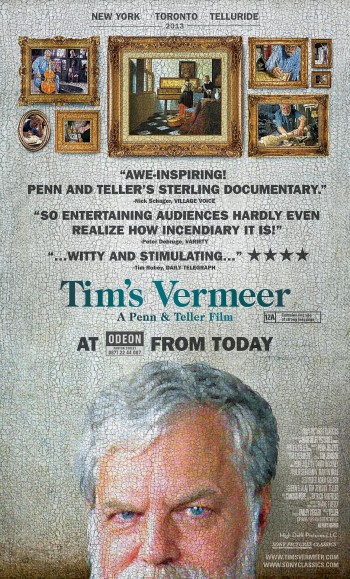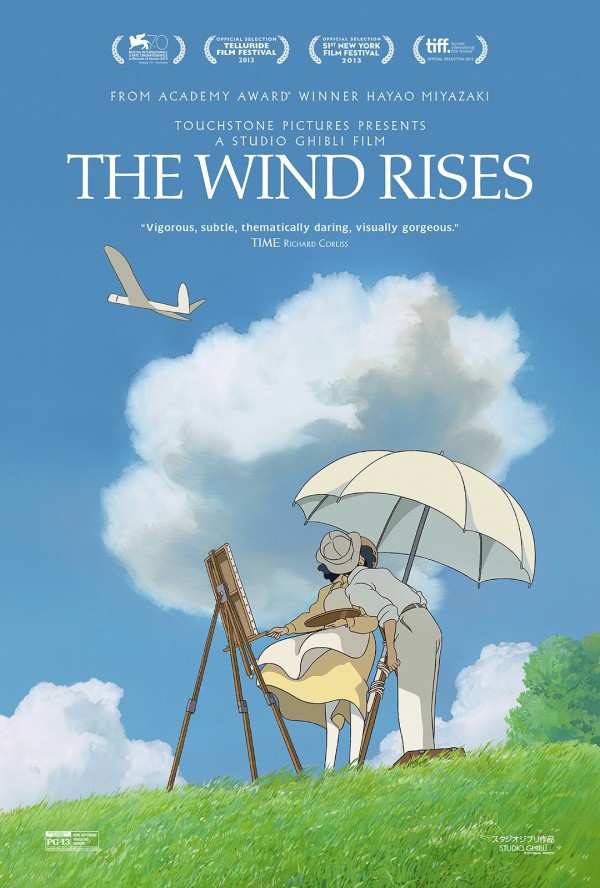THE WIND RISES (2013, directed by Hayao Miyazaki, 126 minutes, Japan)
TIM’S VERMEER (2014, directed by Teller, 80 minutes, U.S.)
 BY DAN BUSKIRK FILM CRITIC Hayao Miyazaki, the wildly imaginative Japanese animator, who has been compared to Walt Disney and Steven Spielberg, has announced with great fanfare that his latest film, a biography of Japanese airplane designer Jiro Horikoshi will be his swan song. Miyazaki has since back-pedaled a bit about retirement (“I might make something short, so nothing has changed really,” he told Variety) but The Wind Rises does have the scent of an autumnal valedictory of a master. Miyazaki, who tuned 73 this year, has made a work that shares traits with final films by Kurasawa. Bergman, Altman and many other retirement seekers, a nostalgic reverie that examines the past’s struggles and gets to the root of his creative impulse.
BY DAN BUSKIRK FILM CRITIC Hayao Miyazaki, the wildly imaginative Japanese animator, who has been compared to Walt Disney and Steven Spielberg, has announced with great fanfare that his latest film, a biography of Japanese airplane designer Jiro Horikoshi will be his swan song. Miyazaki has since back-pedaled a bit about retirement (“I might make something short, so nothing has changed really,” he told Variety) but The Wind Rises does have the scent of an autumnal valedictory of a master. Miyazaki, who tuned 73 this year, has made a work that shares traits with final films by Kurasawa. Bergman, Altman and many other retirement seekers, a nostalgic reverie that examines the past’s struggles and gets to the root of his creative impulse.
Starting in the 1920s and following Horikoshi up to the dawn of WW2, Miyazaki paints another mesmerizing portrait of a time and place, with the details of pre-war Japan – the libraries, the trains, the universities and rural villages – coming to life through animation in a sustained dream-like state that film could never capture. Horikoshi’s bucolic idyll is coming to an end and his witnessing of the devastation of the 1923 earthquake is a portent of the death that will be delivered by air in the forthcoming war. The fact that Horikoshi’s dreams of dazzling aircrafts that will play a part in that destruction hangs over his endless labor.
They’ve added a good but of fiction to the life of Jiro Hirokoshi but the aeronautics pioneer is clearly a stand-in for Miyazaki himself, whose life also included a great deal of slaving over drawings and designs. Where Miyazaki made his figures move, Hirokoshi made them fly, both by obsessing over the details. Miyazaki beautifully captures the single-minded nature of youthful passions, showing how the curve of a fish bone can be an inspiration for a wing support and how friends can fuel each other’s ambitions.
Some of the film’s most thrilling sequences involve Horikoshi’s idol, the audacious Italian aircraft designer Gianni Caproni. Miyazaki’s film shifts into fantasy as the pair enter each other’s dreams and together dance along the plane’s wings while in flight, examining the aircraft’s features while the wind whips through their hair. Outside his dreams, Horikoshi has many setbacks and watching his hard work begin to vibrate then burst into pieces in mid-air allows Miyazaki to indulges in his love of creating objects that transform themselves in a thrilling fashion. In grassy fields, Horikoshi stands at the feet of failure, kicks though the rubble and gets back to work, again and again.
The battle of design rivals take on a political dimension as the war nears which makes for a unique storyline but the film’s second half bogs down a bit with a formulaic story of Horikoshi romance with a young woman suffering with tuberculosis. While the sentimentality gets laid on pretty thick, it is the strength of Horikoshi’s obsessive focus that lingers at the film end, the desire to make something beautiful that captures the wind and takes to the skies. It’s that thrilling sense of possibility that The Wind Rises leaves us with, which makes for a fitting capper to Miyazaki’s uniquely cinematic legacy.
– – – – – – – –
Artistic obsession is the subject of a new documentary from first-time director Teller, better known as the silent half of the illusionist duo of Penn and Teller. Tim’s Vermeer chronicles the mad  pursuits of itech guru Tim Jenison to unravel the secrets of Johannes Vermeer, the Dutch master painter. A master of light, Vermeer captured the element in his paintings with such precision it has long been suspected that he used some sort of mechanic help. Jenison believe he has gotten to the bottom of some of the painter’s “tricks” and he plans to prove it by painting a recreation of one of the painter’s masterpieces, “The Music Lesson” from 1664.
pursuits of itech guru Tim Jenison to unravel the secrets of Johannes Vermeer, the Dutch master painter. A master of light, Vermeer captured the element in his paintings with such precision it has long been suspected that he used some sort of mechanic help. Jenison believe he has gotten to the bottom of some of the painter’s “tricks” and he plans to prove it by painting a recreation of one of the painter’s masterpieces, “The Music Lesson” from 1664.
The most dazzling of Jenison’s discoveries is a simple dental-sized mirror which he uses to match color tones with complete accuracy. With this basic concept Jenison, who isn’t even an amateur painter, plans to copy each dab of color painstakingly to his canvas.
Jenison obviously has money to spare for this project and we follow him as he goes to absurd lengths to recreate Vermmer’s painting studio as it wold be in the 1600s, going so far as to personally grind the lens of the camera obscura because modern lenses are “too perfect.” At a fleet 80 minutes, director Teller has just enough time to give this painting’s creation a sense of drama that climaxes with the final result unveiled to the cameras.
The result is enough to impress master-class painter David Hockney. But if Vermeer used these mechanical techniques does this make the master little more than a 17th Century Jeff Koons, a conceptualist and a copier but not a true artist? That is for the viewer to decide but Tim’s Vermeer makes a convincing case for its belief these mechanical techniques were part of The Master’s trick bag, a bit of demystification that fascinates us with the ramifications.

